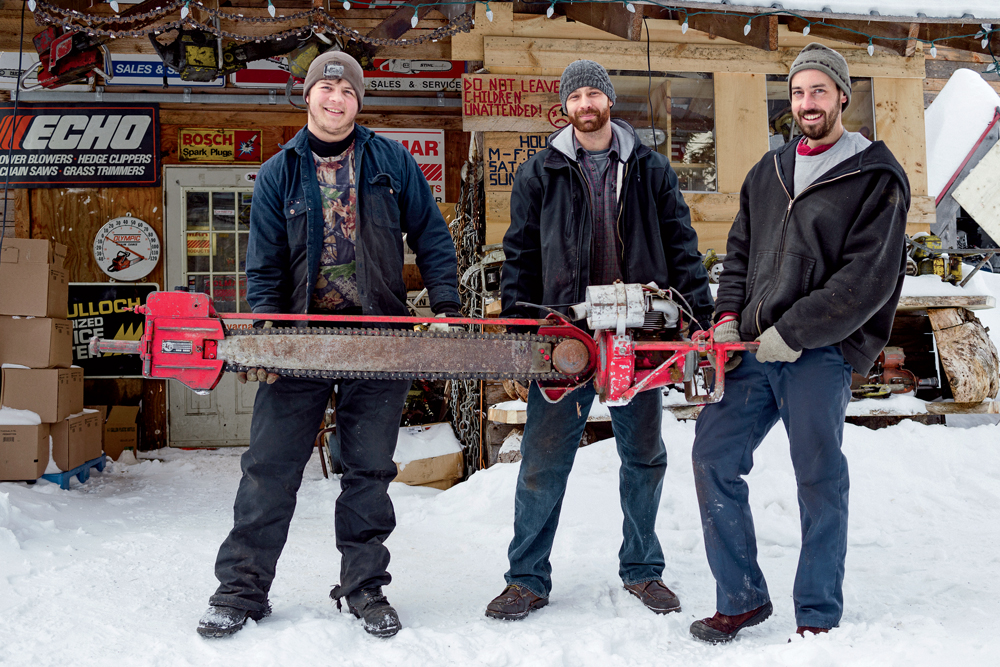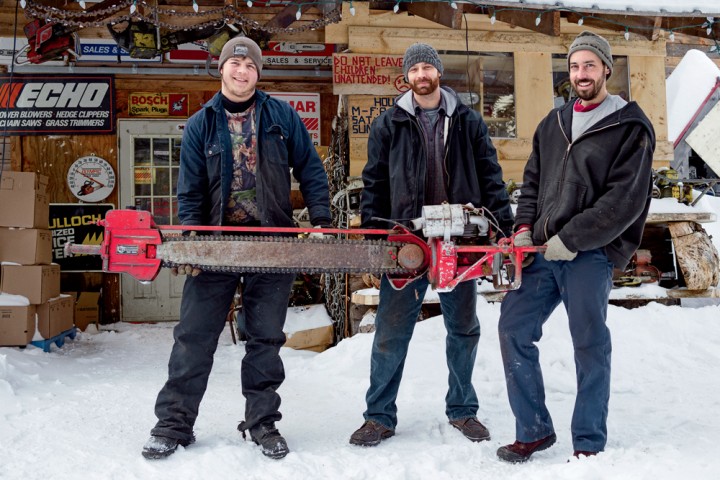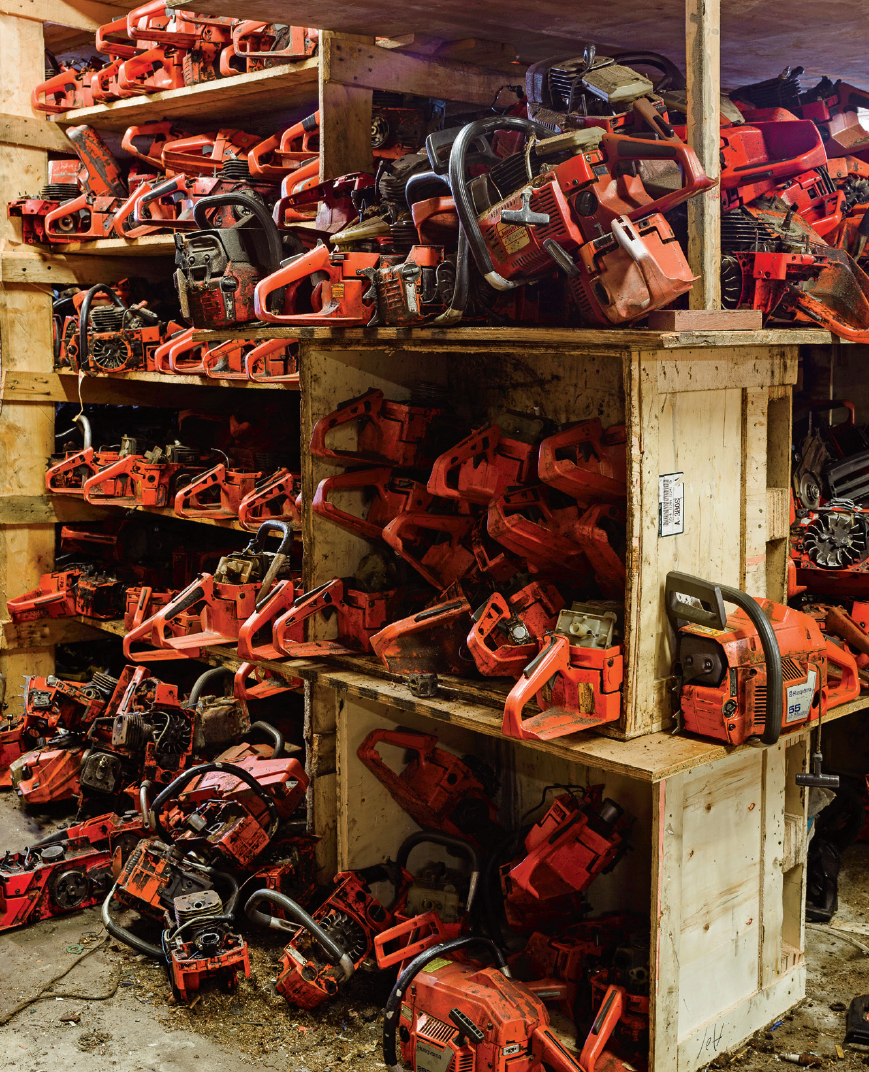Pure Vermont | Repairing Chainsaws
If you want to see an unfiltered slice of rural Vermont, hang out a while at The Chainsawr, chainsaw store and repair shop.

Coffee By Design | Portland, Maine
Photo Credit : Katherine KeenanWhen I was young, I would sometimes go to the woods with my father to cut firewood. My memories of this are a bit hazy, in part because it was 30 years ago or more, and in part because it didn’t happen very often. My father wasn’t a natural-born woodcutter, nor was he a man who relished physical labor in general, and the temptation to purchase firewood from men more suited to the task ultimately prevailed.
Yet something of the work imprinted itself on me, in the form of startlingly specific memories. For instance, I recall loading wood into the back of a vehicle entirely unsuited to the task: the late-’70s Honda Civic wagon my parents drove. And I remember the acrid smell of my father’s saw, a barn-red Jonsered, a brand that has since been purchased by a larger, multinational power-tool conglomerate. Back then, Jonsered chainsaws were popularly known as “Jonesy Red,” perhaps because few Americans knew precisely how to twist their tongues around the brand’s true name, or (and this seems more likely to me) maybe because “Jonesy Red” is simply more fun to say. Try it—you’ll see what I mean.

Photo Credit : Corey Hendrickson
My father’s saw must now be approaching its 40th birthday. Perhaps it’s even as old as I am. I can’t say what has become of it, though I couldn’t help considering its fate on one recent late-winter afternoon, as I stood in the midst of what might be the world’s largest chainsaw graveyard. “Near as I can figure, we’ve got somewhere around 7,000 saws,” Scott DesJardins told me. He’s the founder and owner of the graveyard, which is formally known as The Chainsawr. It isn’t so much a place where chainsaws go to die as it is where they go to be reborn, their usable parts stripped and shipped to all corners of the globe: tiny donated organs of metal, plastic, and rubber.
It isn’t easy to find The Chainsawr, or at least not its physical manifestation (most customers place their orders online). And if you’re inclined to follow the business’s advice, you probably don’t want to call there, either: Unearthing the phone number on the website (store.chainsawr.com) requires a special brand of persistence, which, sometimes according to Scott’s mood, is ultimately rewarded with the following disclaimers:
• The person you end up talking to will be busy, overworked, and grumpy, and doesn’t want to talk to you.
• And, just in case you’re not getting the point … Remember, if you call on the phone you will be talking to somebody who didn’t want to answer the phone in the first place.
Naturally, these warnings served only to imbue me with an insatiable desire to pick up the phone and dial The Chainsawr, just to see how overworked, grumpy, and disinclined to talk to me the person on the other end would be. Still, if I’ve learned anything over my 43 years, it’s that antagonizing grumpy people with chainsaws is not a recipe for my continued health and well-being, so I decided that an in-person visit was warranted.
Downtown Stannard, Vermont, consists of a town hall that’s open exactly four hours each week and a church that features neither electricity nor running water. As I passed between the church and the town hall, it occurred to me that this was precisely the sort of town where grumpy chainsaw repairmen could find the solitude essential to their temperament and chosen profession, for the surrounding hills were thickly wooded, the domain of saw-wielding loggers.
A half-mile farther, I turned off the less-traveled gravel lane onto an even lesser-traveled gravel lane, before pulling into The Chainsawr’s driveway. I exited my car and entered the shop, passing under an assortment of antique chainsaws, most of which looked outlandishly large and cumbersome, like something Bigfoot would use to fill his woodshed.
To the extent that one could sue a business for false claims of grumpiness, I’d have a pretty good case against the The Chainsawr, because both Scott and his sole employee, Levi Chase, a stocky 23-year-old with an air of optimistic youthful energy about him, were congenial and outgoing, albeit indeed quite busy. When I arrived, Levi was just entering the shop from a side door; he’d been outside, putting a customer’s saw through the paces.
“I riched it up significantly,” he said, which, for those of you un-familiar with chainsaw repair-speak, refers to an increase in the fuel-to-air ratio of the saw’s carburetor. He handed the saw over to the waiting customer, who worked on a residential tree-felling and -trimming crew.
As I soon learned, the majority of The Chainsawr’s customers rely on their saws for one of two things (and in some cases, both): their living or their living. The difference is found in the italicized emphasis, with the former being defined by the labor that results in a paycheck, and the latter by the labor that stems the outflow of money: firewood to heat the house; softwood logs to feed a backyard sawmill that will produce the lumber to build a barn or workshop. That sort of thing.
Generally speaking, The Chainsawr isn’t the sort of place where casual chainsaw users are found, and it’s not hard to see why. The overall aesthetic is raw in a distinctly rural way: A shotgun hangs casually above a row of chainsaw bars, and the viewing glass in the woodstove that heats the shop shattered on a recent 20-below-zero morning. Someday it will be replaced. Then again, maybe it won’t. There’s no customer bathroom (there’s no bathroom), and customer seating consists of a yellow-birch slab set atop two buckets of spent hydraulic fluid. There are three visible clocks in the shop; at the time of my visit, one was set at 6:05, another at 7:55, and the third at 9:52.
Still, it’s my observation that the value of a business to its community is often inversely proportional to its amenities, an equation that’s certainly applicable to The Chainsawr. During my three-hour visit, I watched Levi repair three chainsaws while their owners—all professional woodsmen—occupied the aforementioned birch slab. And I hadn’t been in the shop more than 90 minutes before Scott sent a customer home with a new chainsaw, receiving in return nothing but a promise to pay.
The shop banter was that of working-class men the world over, full of unprintable phrases and the regional rural vernacular, punctuated by a particular brand of quasi-morbid humor regarding the state of the mechanical contraptions these men rely on:
Customer: “How’s Levi today?”
Levi: “Not too awful bad.”
Or:
Customer (as Scott returns from tuning his saw): “Looking good?”
Scott: “No, it’s not. Actually, it’s never going to look any better.”
Or:
Customer (apropos of nothing): “If I’d known I was gonna live this long, I’d’ve taken better care of myself!”
As I soon learned, hanging out at The Chainsawr provides a view into the rural North Country economy that’s unlikely to be written into any textbook. For instance, I learned of the connection between maple syrup and chainsaws (a good sugaring year equates to disposable income for precisely the sort of people inclined to treat themselves to a new saw when the opportunity presents itself). And I learned that loggers who rely on John Deere skidders need more chainsaw repairs than loggers who rely on competing skidder brands (the cabs on the Deere skidders are particularly tight, resulting in makeshift saw storage on the machine’s exterior, which leads to frequent skidder/saw altercations). I learned, too, that ideal logging conditions do not, as I would have expected, result in increased sales, because when conditions are ideal, nothing short of catastrophic equipment failure will coax a logger out of the woods. “They’ll run their main saw until it won’t run; then they’ll run their spare saw until it won’t run; and maybe then we’ll see ’em,” Scott explained. Still, Scott has learned to be patient. Besides, a good winter—one where the ground freezes early, allowing the machines ready access—always pays off eventually.

of makes and models await repair or recycling.
Photo Credit : Corey Hendrickson
I was surprised to learn that Scott is only 30; he lives with his family in a house they bought cheap and renovated. It’s only a few feet from the shop’s front door. This may sound patronizingly obvious, but he loves chainsaws, and considers them a marvel of engineering and ingenuity. “Chainsaws are totally unique in terms of how long they last, what you pay for them, and what you get out of them,” he says. “They weigh under 20 pounds, run at 14,000 rpm for eight or nine hours a day, six days a week, and last five years before you have to spend a few hundred bucks on a rebuild. There’s nothing else out there that’ll do that.”
When Scott was a high-school student in South Burlington, Vermont, he took an aptitude test. The result was surprising to him, primarily because he’d never heard of the job title skidder operator.
“I had no idea what that was,” he told me. “I got on Yahoo and said, ‘Oh my God, that’s the coolest thing.’”
Although it’s true that his career doesn’t involve operating skidders on a regular basis, it’s also true that chainsaws and skidders are kissing cousins. Furthermore, he recently took delivery of a Timberjack 205 skidder, which he plans to restore “for fun.”
I took my leave of The Chainsawr in the early afternoon. Levi was out back; I could hear the revved-up mosquito sound of the saw he was tuning. Maybe he was riching it up, though he might just as likely have been leaning it out. Scott was scrolling through online parts orders. The phone rang. “Hello—Chainsawr,” he answered. He didn’t sound the least bit grumpy to me.
Ben Hewitt’s fourth book, The Nourishing Homestead: One Back-to-the-Land Family’s Plan for Cultivating Soil, Skills, and Spirit, was published last year by Chelsea Green. benhewitt.net








Scott and Levi are “The Best” chainsawr’s working ! If you don’t believe me, give them a try …..
Nick